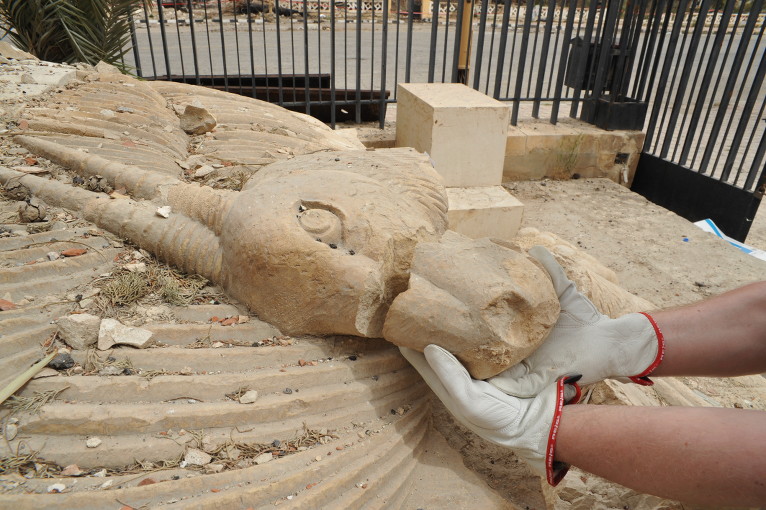Organizing the exhibition “Endangered Heritage. Syria and Iraq in the research of the Polish Centre of Mediterranean Archaeology” we expected to be telling the story of our excavation and conservation projects suspended in 2011 with the advent of the Syrian civil war. The takeover of Palmyra from the Daesh by government forces a few days ago changed that entirely.
With fresh news on the situation in Palmyra, the scene of almost half a century of Polish archaeological research, representatives of the Syrian Directorate General for Antiquities and Museums approached the PCMA to send Polish experts urgently to Palmyra to assess the damage to objects excavated and conserved by our mission. Conservator Bartosz Markowski and archaeologist Robert Żukowski arrived in Palmyra on April 8 and stayed there until April 14, 2016.
Photographs showing the destruction of Palmyra and of the museum left no doubt that urgent action was required. Archaeologists and conservators with good knowledge of the Palmyra collection were needed to help identify and secure fragments of individual objects with a look to their future reconstruction. Many of these objects came from PCMA excavations, and Bartosz Markowski, a member of our mission, had arranged the display in the exhibition halls. A decade ago he had also reconstructed the Lion of Allat, one of the most recognizable symbols of Palmyra.
Bartosz Markowski and Robert Żukowski on their work in Palmyra:
The Museum building has been devastated and seriously damaged in the fighting. The equipment in the rooms has been completely destroyed; there are no windows, the ceiling panels have caved in, the furniture is broken and the display cases are overturned and lying on the floor.
Most of the museum objects have been damaged. The most affected are the sculptures and reliefs on the ground floor. Faces and hands of portrait statues were targeted specially on ideological grounds. The scale of the destruction is unprecedented: of the roughly 200 exhibited portraits, only four have survived unscathed. Statues and larger funerary reliefs were thrown down and broken.
We have protected the damaged sculptures on the ground floor, where most of the collection was housed. The rooms have been cleared of glass and rubble. Sculpture fragments recovered from the rubble have been matched to sculptures and stored in cardboard boxes. Whenever possible, the recovered face fragments and larger pieces were reattached with a handy supply of conservation materials brought specially for the purpose.
Masterpieces discovered by the Polish mission were damaged as well. The sculpture of Athena-Allat was decapitated, its arms broken off and the folds of the robes and facial features hammered. The monumental Lion of Allat, conserved by the PCMA mission a decade ago, was toppled with a bulldozer, breaking the reinforced concrete support structure. The muzzle and other details of the sculpture had been smashed to pieces. The recovered fragments of these sculptures will be refitted once conservation begins.
Comment by the Director of the Polish Centre of Mediterranean Archaeology, University of Warsaw, dr. hab. Tomasz Waliszewski:
We decided to send our experts to Palmyra reacting to the specific needs of our Syrian partners protecting the cultural and archaeological heritage of their country. Being part of the international community of archaeologists and conservators, we have been monitoring the situation in Palmyra with dismay. There is an urgent need now to help in damage assessment of objects in the archaeological museum. The long-lasting presence of Polish scholars in Palmyra made it a must from our point of view — our teams from PCMA University of Warsaw have been working there from 1959 until 2011, and have contributed many important discoveries stimulating research on this unique oasis city.
Our Syrian partners are currently defining the most urgent needs in the situation. On our part, we are considering a Polish contribution to the preservation of Palmyra’s monuments. Our archaeological and conservation experts could participate in the revival of the Palmyra Museum. Their work could involve cooperation in inventorying the damages, conservation of objects and initial arrangement of the exhibition halls. These actions are scientific and cultural in essence, but they will also benefit the residents of Palmyra.
In the next few days, the University of Warsaw will be hosting some of the most prominent archaeologists working in Palmyra. They are expected to discuss possible scenarios of action on behalf of preserving Palmyra’s heritage. Naturally as soon as such work will become possible.

